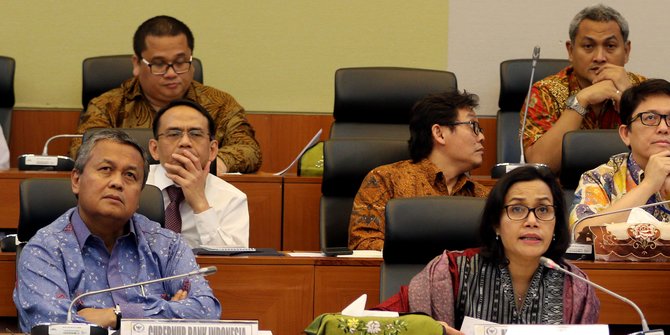
2019 RAPBN IN THE MIDDLE OF GLOBAL UNCERTAINTY
2018 is marked by a global
economic turmoil that is not easy. The economic policy of the United States has
a huge influence on the whole world. With global conditions full of uncertainty
and turbulence, strong safeguards and bearings are needed so that the national
economy can survive amidst shocks. The 2019 Draft State Budget is prepared
using macro assumptions that are also overshadowed by the uncertainty of the
global economy, therefore the government is compiling with the principle of
greater caution.
Projected economic growth of 5.3%,
inflation rate of 3.5%, rupiah exchange rate of Rp.14,400 / usd, 3-month spn
interest rate of 5.3%, Indonesian crude oil price of USD70 / barrel, 750ribu
barrel oil lifting per day and gas lifting is estimated at 1,250,000 barrels
per day.
The 2019 State Budget Draft was
delivered by President Joko Widodo at the DPR Plenary Session on August 16,
2018.
State revenue is targeted at
Rp.2,142.5 trillion obtained from tax revenues of Rp.1,781.0 trillion, non-tax
state revenues of Rp.361.1 trillion and grants of Rp.4.4 trillion. Meanwhile,
state expenditures are budgeted at Rp 2,439.7 trillion with central government
expenditure allocations of Rp 1,607.3 trillion and transfers to regions and
village funds amounting to Rp 832.3 trillion. In the 2019 RAPBN there is a
deficit of Rp. 297.2 trillion or 1.84% of GDP.
The APBN deficit continues to be
reduced at the level of 1.83% of GDP as a form of increased caution. For the
first time since 2013, the APBN was designed with a deficit of under 2% of GDP.
The maintained APBN deficit in a downward trend is a healthy and sustainable
APBN indicator.
Another APBN health indicator is
the primary balance deficit of 0.13% which is the lowest number since 2012. A
healthy, credible and sustainable budget is a strong capital in resisting
global shocks.
Increased transfers to regions and
village funds from Rp. 633.6 trillion to Rp. 832.3 trillion were directed
towards strengthening the implementation of fiscal decentralization and
achieving Nawacita. The biggest element of transfers to the regions is the
general allocation fund which increased from Rp401.5 trillion to Rp414.9
trillion. As for village funds, strengthening the role of the village was
realized by increasing the average amount of village funds received from Rp.
800.5 million to Rp. 973.9 million.
The 2019 Draft State Budget is
also designed to be more independent which can be seen from the growth of state
revenues by 12.6%. When compared with growth in 2014-2017 with an average
growth of 3.8%, this 2019 growth is very sharp. In terms of taxation, the
contribution of state revenue from taxes increased from 74% in 2014 to 83.1% in
2019.
 English
English Japan
Japan

selamectin vs ivermectin stromectol order online how long is ivermectin effective how much ivermectin for a potbelly pig
provigil cost can you get modafinil over the counter provigil and cla supplement s how much is provigil in mexico
gnc vitamins and supplements cialis and women usage viagra jelly reviews for men viagra en ligne sildenafil tablets natural male enhancement supplement
dosage for furosemide furosemide 40 mg without prescription furosemide dose in renal failure where to buy lasix
neurontin pi neurontin 600 mg coupon does neurontin help with suboxone withdrawal what happens when you stop taking gabapentin suddenly
cialis samples for providers buy seed packets viagra jokes female enhancement pills that work illegal drug capsule identification herbicide groups chart levitra vs viagra viagra prescription walmart cialis prices without insurance taking viagra with cialis viagra prescription what does viagra do sildenafil citrate prices walgreens viagra problems side effects cialis generic lowest prices viagra vs.levitra natural viagra alternatives that work natural viagra better than viagra and cialis taking viagra cost of viagra at walmart viagra cost per pill chewable viagra walgreens online coupons men herbal supplements sildenafil citrate 100mg tablet sildenafilo minute clinic insurances accepted sample medications for physicians how much viagra should i take viagra foods trimix penile injection videos
prednisone depression can you drink while taking prednisone what is prednisone 10 mg used for
prednisone deltasone prednisone 10mg dose pack instructions what does prednisone do for bronchitis
plaquenil guidelines 2018 buy plaquenil in india can you have alcohol on plaquenil plaquenil retinal toxicity in what layer of the retina
zithromax 1gm azithromycin india cost is azithromycin safe to take while pregnant how long does it take for azithromycin to kick in
provigil side effects duration of action for provigil how long to stay up with modafinil
how long does cialis last cvs mail order phone number generic for viagra 100mg viagra generic motrin professional samples gnc natural viagra substitute 100mg viagra without a doctor prescription
azithromycin allergies azithromycin online australia where can i buy zithromax azithromycin how to take azithromycin 250mg tablets
how furosemide works lasix 30 mg what is furosemide 20 mg used for how much lasix can i give my dog
amoxicillin ear infection amoxicillin without dr script will amoxil treat tick bite why does amoxil make my mouth hurt
youtube erectile dysfunction remedies best male libido enhancing supplements street value for viagra female viagra pill pfizer for healthcare professionals best price on cialis 5mg
albuterol covid ventolin over the counter usa ventolin hfa 108 90 base what happens if you over use ventolin
prednisone for swelling prednisone 12 mg can i eat eggs while taking prednisone how to taper prednisone
my modafinil where to buy modafinil where to get provigil online how long for modafinil to arrive
how to make viagra pills viagra generic vs brand street value of 100mg viagra order viagra pills online how quickly does flomax work pink girls from grease sildenafil 100 mg